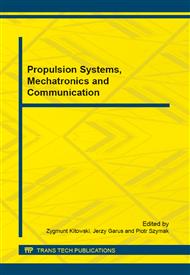[1]
T.I. Fossen, Guidance and Control of Ocean Vehicles, Wiley, Chichester, (1994).
Google Scholar
[2]
T.I. Fossen, Marine Control Systems, Marine Cybernetics AS, Trondheim, (2002).
Google Scholar
[3]
T.I. Fossen, Handbook of Marine Craft Hydrodynamics and Motion Control, Wiley, Chichester, (2011).
Google Scholar
[4]
J. Garus, Adaptive Track-keeping Control of Underwater Robotic Vehicle. Int. J. Math. Models and Methods in App. Sci. 4 (2007) 217-222.
Google Scholar
[5]
J. Garus, B. Żak, Using of Soft Computing Techniques to Control of Underwater Robot, IFAC 15th Int. Conf. Methods and Models in Automation and Robotics, Międzyzdroje (2010) 415-419.
DOI: 10.1109/mmar.2010.5587198
Google Scholar
[6]
D. Goldberg, Genetic Algorithms in Search, Optimisation and Machine Learning. Adison-Wesley, New York, (1989).
Google Scholar
[7]
B. Lantos, L. Muton, Nonlinear Control of Vehicles and Robots, Springer-Verlag, London, (2011).
Google Scholar
[8]
J. Małecki, Fuzzy Track-keeping Steering Design for a Precision Control of the Ship, Sol. State Phenomena 196 (2013) 140-147.
DOI: 10.4028/www.scientific.net/ssp.196.140
Google Scholar
[9]
Z. Michalewicz, Genetic Algorithms + Data Structures = Evolution Programs, Springer-Verlag, New York, (1994).
Google Scholar
[10]
K. Ogata, Modern Control Engineering, Prentice Hall, New Jersey, (2002).
Google Scholar
[11]
F. Song, P. E. An and A. Folleco, Modelling and Simulation of Autonomous Underwater Vehicles: Design and Implementation, IEEE J. Ocean. Eng. 2 (2003) 283-296.
DOI: 10.1109/joe.2003.811893
Google Scholar
[12]
M.W. Spong, M. Vidyasagar, Robot Dynamics and Control, Wiley, Chichester, (1989).
Google Scholar
[13]
P. Szymak, Selection of Methods for Underwater Robot Control, Sol. State Phenomena 164 (2010) 149-154.
DOI: 10.4028/www.scientific.net/ssp.164.149
Google Scholar
[14]
B. Żak, S. Hożyń, Low-Cost MEMS Accelerometers for Short Duration Micro ROV Distance Measurement, Sol. State Phenomena 210 (2014) 280-286.
DOI: 10.4028/www.scientific.net/ssp.210.280
Google Scholar


